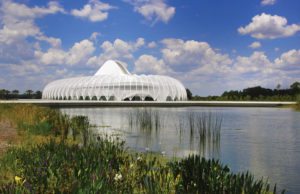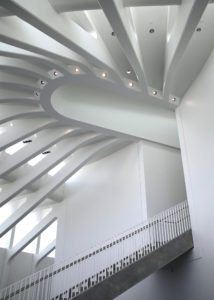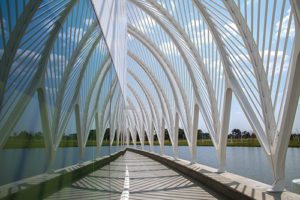Florida Polytechnic University
 Central Florida boasts a new landmark that is not another theme park or resort yet draws attention on a global scale. The icon is Florida’s newest state university whose signature building is a spectacular example of modern architecture that is turning heads along Interstate 4 in Lakeland.
Central Florida boasts a new landmark that is not another theme park or resort yet draws attention on a global scale. The icon is Florida’s newest state university whose signature building is a spectacular example of modern architecture that is turning heads along Interstate 4 in Lakeland.
Florida Polytechnic University’s Innovation, Science and Technology Building is a 162,000-square-foot white oval structure encircled by arching pergolas and topped with operable louvers that open and close like a giant clam shell.
The Innovation, Science and Technology Building is the primary classroom building and central hub of campus activity at Florida Poly, which opened for classes in August 2014. The unconventional building is as innovative as the new university, whose mission is to educate 21st century learners in STEM – science, technology, engineering and mathematics.
Whether your fi nal destination is Walt Disney World in Orlando or Busch Gardens in Tampa, keep an eye out for this remarkable structure on your journey. The view of the building, which is highly visible from I-4, is one for the memory books. There is nothing else quite like it.
Designed by Spanish architect Dr. Santiago Calatrava, the Innovation, Science and Technology Building – known around campus as “the IST Building” – can be seen from the highway as you approach Exit 41 toward Auburndale. Inspired by the surrounding marshes and lakes of Central Florida, the architect positioned the IST Building at the north end of a chain of terraced refl ecting pools that fl ourish with aquatic plants and wildlife.
approach Exit 41 toward Auburndale. Inspired by the surrounding marshes and lakes of Central Florida, the architect positioned the IST Building at the north end of a chain of terraced refl ecting pools that fl ourish with aquatic plants and wildlife.
The Innovation, Science and Technology Building gives new meaning to the term “modern marvel.” Surrounding the IST Building are 84 arched white pergolas that shade terraces and walkways. Atop the roof are 94 automated operable louvers that move throughout the day to provide shade and passive solar lighting.
Inside the IST Building is an 11,000-square-foot common area on the second fl oor, under the building’s cupola, as well as 26 classrooms and 11 innovation labs. The research areas include the super-computing lab – a room-sized IBM computer that has the capacity to crunch huge volumes of data in just nanoseconds. There also is the RAD Makerspace Lab, which contains 3D printers, object scanners and Rapid Application Development (RAD) technology.
The university’s expansive second-fl oor is home to one of the nation’s first all-digital libraries. There are no bookshelves. Instead, students can access more than 135,000 ebooks and research papers online via the library’s computers or their own personal computing device. Staff librarians are on hand to help navigate virtual resources.
Florida Polytechnic University is dedicated to educating students in a technology-rich environment that prepares them for the high-tech jobs and careers of tomorrow. Students at Florida Poly can focus their studies on cyber security, cyber gaming, health informatics, motion intelligence and more than a dozen other cutting-edge technologies. STEM fi elds like these are expected to grow in coming years.
 Florida Polytechnic’s high-achieving students are the next generation of computer scientists, engineers, innovators and entrepreneurs, and the university is one of this nation’s great campuses in the making.
Florida Polytechnic’s high-achieving students are the next generation of computer scientists, engineers, innovators and entrepreneurs, and the university is one of this nation’s great campuses in the making.
If you would like to learn more about Florida Polytechnic, visit flpoly.org. If you have a student who is interested in attending Florida Poly, you can schedule a campus visit at BetheNext.com.

